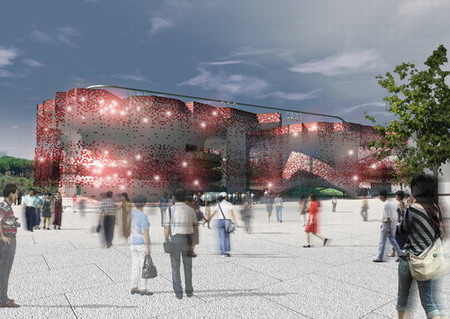They will also have insight into the four themes of the exhibition: water quality, air quality, public transport and sustainable construction.
After the ramp and the exhibition area, visitors will move into the urban area on the ground floor, where a multifunctional stage, a shop, and a restaurant combine with the urban setting, providing visitors with a sense of what it feels like to be in a bustling city.
At the top end of the ramp of the exhibition area, visitors can see a 10-meter-high projection screen in the atrium, on which scenes of the IMAX film "The Alps," showcasing magnificent Swiss mountain scenery, is being projected. In a continuous loop, the film shows broad landscape views that sweep deliberately slowly across the mountain slopes highlighting the omnipresence of the Alps mountain range in Switzerland.
Aside from the beauty of the mountain, the film also represents a harsh and hard environment.
|

Facade of the Swiss Pavilion[en.expo2010.cn]
|
After visiting the exhibition, visitors will come to the second cylinder of the Swiss Pavilion, where they can start the tour on the chair lift.
The second cylinder is open at the top and its walls are planted with greenery. Accompanied by sounds from nature, visitors will take an eight-minute chair lift ride up the cylinder to the natural space on the roof of the Pavilion.
The chair lift provides a link between the urban space and the natural space of the Swiss Pavilion, which allows visitors to access nature from the urban area and vice versa. It takes visitors out of the demanding, urban environment into the relaxing rural setting and back again.
Covered by a green meadow, plants and flowers, the roof of the Swiss Pavilion is an open, bright and peaceful landscape. Accompanied by relaxing sounds from nature, visitors can glide across the exuberant green meadow and enjoy the beautiful natural space.
The interactive, intelligent facade of the official Swiss Pavilion shows how much unused energy is all around us.
The facade that envelops the Pavilion is a curtain of woven aluminium elements under which visitors pass to access the urban area on the ground floor of the building. LED lights comprised of an energy source, a storage unit and a consuming unit are incorporated into the facade. The energy produced is made visible in the form of flashes that are triggered by the pavilion surroundings, such as the sun or flashes made by visitor cameras.
Since each solar cell is independent of the others, the whole system is, to a certain extent unpredictable, which results in a haphazard pattern of flashes. Thanks to the storage of energy in each individual cell, the facade is also active at night, when the cells will trigger each other.
Each cell bears a map of Switzerland, making the whole Pavilion into a "Swiss" drape.

